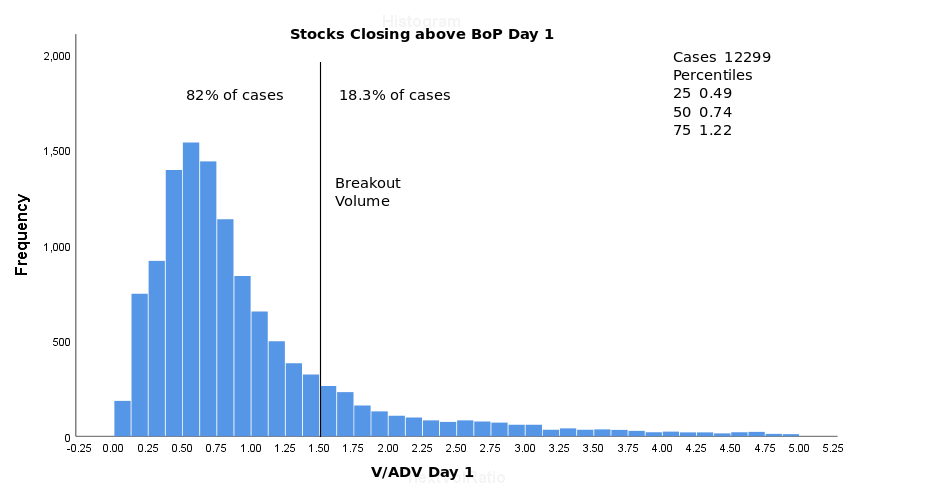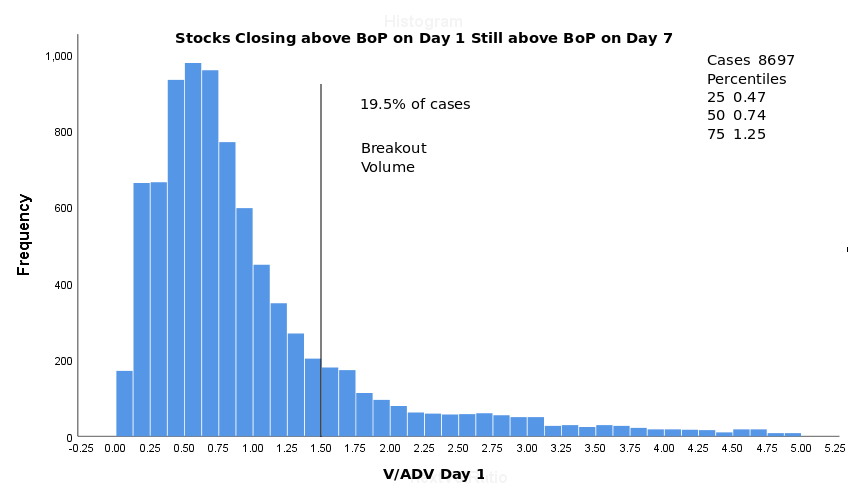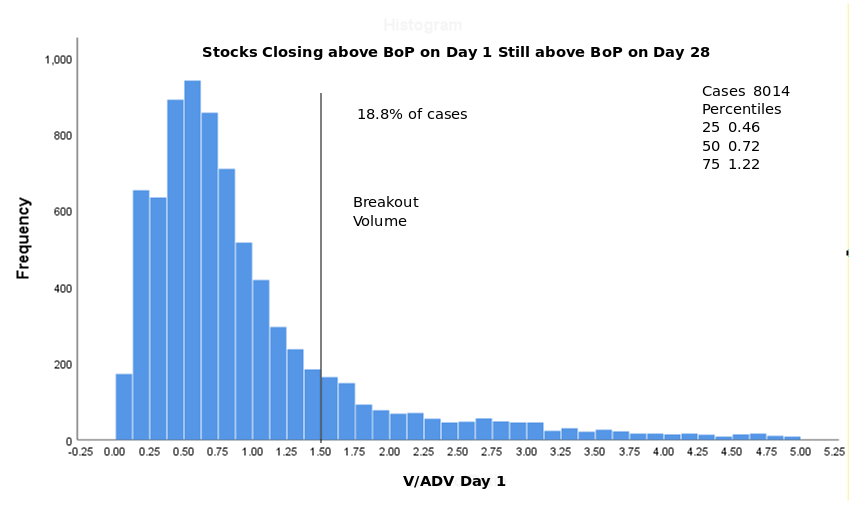
In How to Make Money in Stocks, William O'Neil wrote that stocks in a Cup and Handle pattern could be bought if the breakout day volume was at least 50% higher than the average daily volume. There are many other criteria that must be met also, as defined in the CAN SLIM criteria, but this is one criteria that is easily quantified and recognized. On breakoutwatch.com, I call this the breakout volume calculated as 1.5 times 50 day average volume.
When we designate a stock as a "breakout" we only do so if the stock closes above the "Breakout Price" and the volume that day is 50% higher than the 50 day average volume, called the 'breakout volume'. Our subscribers may conclude that a stock should only be bought if that volume threshold is met.. I decided to look at how breakout day volume affects the short to medium term prospects for a stock. To do so, I looked at stocks that were still above breakout price after 7 days (short term gain) and 28 days (medium term gain).
Methodology
Although we have breakout data back to 2001, I chose to use cup and handle pattern watchlist data from 2010 to 2019. as data has been collected on a consistent basis since then. As 2020 has been an atypical year, I excluded 2020 from the analysis. From this collection, I selected stocks that closed above their breakout price on the day after they appeared on the cup and handle watchlist. I called this day 1. For each of these stocks, I calculated the ratio of the volume on that day and divided it by their 50 day average volume giving me a ratio of volume to average volume (V/ADV). I then looked at how many of these stocks were still above their breakout price after 7 days (day7) and 28 days (day28).
Analysis
If breakout volume of 1.5 time average volume is an important indicator of how a stock will perform in the short to medium term, then on days 7 and 28 we should find that the majority of stocks still above their breakout price (BoP) have a V/ADV value greater than 1.5.
Chart 1 shows a histogram of the number of stocks that exceeded their breakout price on day 1. Only 18% of stocks had a V/ADV of 1.5 or more, and would have been designated as a breakout.

Chart 1
Chart2 shows a histogram of the the same stocks who were still above their breakout price after 7 days. If the 1.5 times ADV requirement for a breakout is significant, we should see the histogram shift to the right with many more stocks above the 1.5 V/ADV line. What we observe is that the number of cases still above BoP has dropped by 3602 but the percentage of those cases that started with a V/ADV of 1.5 has increased only slightly.

Chart 2
Chart 3 shows shows stocks that are still above BoP on day 28. The number of cases has fallen slightly from those that were still positive on day 7, but there is still only a small percent of cases that had an initial V/ADV of 1.5.

Chart 3
Conclusion
Table 1 summarizes the information contained in the charts above. The charts clearly show that selecting stocks with a V/ADV > 1.5 does not significantly improve the probability that a stock will be above its BoP after 28 days compared to selecting any stock that closed above its BoP on day 1. Furthermore, being focused solely on stocks that meet our 'breakout price and volume' criteria misses the vast majority of stocks that meet the breakout price but don't meet the breakout volume requirement, but nevertheless are viable candidates.
| Cases | % | Cases
with V/ADV > 1.5 |
% | |
| Day 1 | 12,299 | 100.0 | 2,250 | 100.0 |
| Day 7 | 8,697 | 70.7 | 1,695 | 75.3 |
| Day 28 | 8,014 | 65.2 | 1,506 | 66.9 |
Table 1